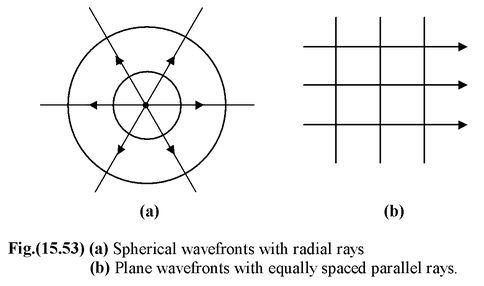
Wave Optics
Optics of Class 12
Wavefronts and Rays
A wavefront is defined as a surface joining the points of same phase. The speed with which the wavefront moves onwards from the source is called the phase velocity or wave velocity. The energy of the wave moves in a direction perpendicular to the wavefront.
Fig.(15.56) shows light waves emitting out from a point source forming a spherical wavefront in three dimensional space. The energy travels outwards along straight lines emerging from the source, that is, radii of the spherical wavefront. These lines are called the rays.
Important
1.Rays are perpendicular to wavefronts
2.The time taken by light to travel from one wavefront to another is the same along any ring.

Huygen’s Principle
1.Every point on a wavefront vibrates in same phase with same frequency
2.Every point on a wavefront acts like a new independent source and sends at a spherical wave, called a secondary wave.
3.Wavefronts move in space with the velocity of wave in that medium.
Coherent Sources
Two sources are coherent if they have the same frequency and a constant phase difference. In this case, the total intensity I is not just the sum of individual intensities I 1 and I 2 due to the two sources but includes an interference term whose magnitude depends on the phase difference.
I = I 1 + I 2 + 2√I 1 I 2 cos φ (15.29)
where φ is the phase difference.
The interference term averaged over many cycles is zero if
(i)the sources have different frequencies
(ii)the sources have the same frequency but no constant phase difference
For such incoherent sources: I = I 1 + I 2
Unlike sources of sound waves, two independent sources of light can not be coherent. Because sound is a bulk property of matter while light is a characteristic of individual atoms which emit light randomly and independent of each other.
In practice coherent sources are produced either by dividing the wavefront (as in the case of Young’s Double Slit Experiment, Fresnel’s biprism, Lloyd mirror etc.) or by dividing the amplitude (as in the case of thin films, Newton Rings, etc.) of the incoming waves.









